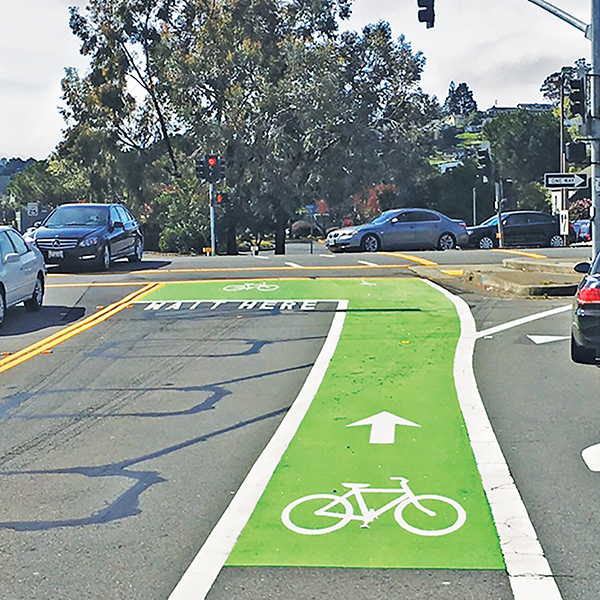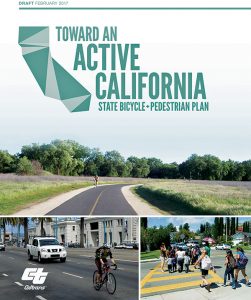
Are there areas in your community where you don’t feel safe biking, or can’t bike at all?
An effort is underway to address these roadblocks and make the Bay Area safer for residents who depend on biking for their transportation needs. These residents can shape the effort by sharing their thoughts about a new bicycle plan from Caltrans District 4, the section of the state’s transportation department representing the nine-county region. Additional districts around the state will be moving forward with their own plans as well.
District 4 officials are conducting an online survey, holding focus groups, and preparing for community workshops in May, which happens to overlap with National Bike Month. A technical advisory committee, bicycle advocates, and community-based organizations are also contributing to identify bike network needs.
Accommodating the Bay Area’s mix of urban and suburban communities — while improving bike safety and mobility across the state highway system — is the big challenge District 4 officials face. They oversee more than 700 miles of freeways and expressways and 1,500 miles of “non-freeway” highways, and hope their plan will address barriers to bicycling on and across these thoroughfares.
Dedicated bikeways and traffic-easing measures that lower auto speeds are strategies under consideration by District 4 officials. An emphasis on first- and last-mile connections to transit and better linkages to networks with crossings and intersections could also help local bicyclists.
San Rafael is a “great example” of a city that will benefit from the District 4 bike plan, said Bjorn Griepenburg, policy and planning director at the Marin County Bicycle Coalition, a group advocating safe biking for transportation and recreation. San Rafael is cut in half by Highway 101, while the eastern part of the city is divided by Interstate 580. Not only is it difficult to get across the freeways, but it also can be dangerous to navigate surface streets via bike, he said.
The district-level work builds on goals and objectives in Caltrans’ first-ever state bicycle and pedestrian plan, Toward an Active California. Set for finalization in April, the plan outlines proposed changes and improvements to safety, mobility, preservation, and social equity, according to a draft.

Caltrans’ statewide plan, Toward an Active California, is set for finalization in April.
“The statewide plan is more of a policy-level plan, filled with strategies and actions that Caltrans and the state can take to improve walking and biking,” said Sergio Ruiz, District 4 bike coordinator, “whereas the district plans get into the physical transportation network and look at specific projects.”
The work by District 4 and others will eventually pave the way toward Caltrans’ vision that by 2040, “people in California of all ages, abilities, and incomes can safely, conveniently, and comfortably walk and bicycle for their transportation needs.”
“That [vision] means we have designed streets where people are the priority,” said Nicole Ferrara, executive director of Walk SF, an advocacy group that promotes walking and lobbies for safe pedestrian access in San Francisco. “Parents with a three-year-old feel comfortable walking across the street, or hopping on a bike with the child. And an 85-year-old feels comfortable walking to the bus,” she explained.
Caltrans’ vision also merges with other pressing concerns, including improving public health and supporting an active lifestyle; creating connections for biking to work, school, or transit; and reducing traffic congestion and greenhouse gas emissions.
The Toward an Active California draft highlights street design approaches that boost bike connectivity and comfort. These include green, buffered bike lanes on Alpine Road across the Interstate 280 ramps in San Mateo County, and green bike boxes that create space between cars and the crosswalk at the Blackfield Drive and Greenwood Cove Drive approaches to State Route 131 in Tiburon.
“The statewide plan illustrates the type of projects [Caltrans] is interested in seeing more,” explained Scott McDonald, senior transportation planner at the Transportation Authority of Marin, which is among the agencies participating in the District 4 bike plan technical advisory committee.
As the District 4 plan and others evolve, officials will feed bicycle and pedestrian data about existing infrastructure and use into a central database. Many of California’s 58 counties and 482 cities have completed active transportation plans, but there isn’t a central data collection point.
Overall, transportation advocates said they’re pleased to see Caltrans lead an effort to improve biking and walking conditions, but they feel there is some room for improvement. Walk SF’s Ferrara said her organization would like to see more specifics in the state plan about using technology to engineer safe streets and prevent fatal injury.
She noted that legislation introduced in February offers one enforcement idea. Assembly Bill 342 (Chiu) calls for an automated camera pilot program in San Francisco and San Jose to identify and ticket drivers traveling 10 miles per hour over the posted limit.
“We spend in San Francisco $35 million a year treating traffic injuries; half of that is paid through public dollars like Medicare and Medicaid,” Ferrara said.
Beyond safety issues, advocates also expressed concern about lack of funding. “To some degree, the state will have to put the money where its mouth is when you adopt a plan like this,” Griepenburg said about Toward an Active California, adding, “The plan acknowledged it won’t be possible without increased investment.”
Toward an Active California assesses the preliminary financial commitment required to tackle critical needs. The plan lays out several investments that are intended to describe “high-level needs and to start a conversation on funding active transportation,” according to the draft.
For example, at least $4 billion in infrastructure investments will be needed to triple bicycle commute mode share. The draft does not contain cost estimates for specific district projects, which could be difficult to pay for at a time when state transportation demands outweigh the supply of funds.
Governor Jerry Brown included in his 2017-18 state budget a proposal to increase annual funding by $100 million for the Active Transportation Program, which supports walking, biking, and Safe Routes to School projects. But that will fall short of local-level demand for investments, totaling more than $1 billion in annual requests, according to a California Bicycle Coalition news release.

Using the District 4 survey and other online resources, the Monitor has put together a bicycle network photo tour to raise people’s awareness and encourage them to get involved in Caltrans’ planning process. View the tour here.
In terms of the Bay Area’s bike plan, District 4’s Ruiz said he and his team will begin gauging funding needs and recommendations this spring after evaluation of survey results and workshop input. They will then pinpoint demand for regional projects and weigh implementation. Going forward, there could be opportunities to partner with local agencies that want to fund and sponsor bike projects, he said.
“We want to prioritize projects that can lead to higher rates of biking as well,” Ruiz said.
A draft of the District 4 bike plan is expected this fall. The final plan is due next winter.
Cecily O’Connor covers transportation for the Monitor.